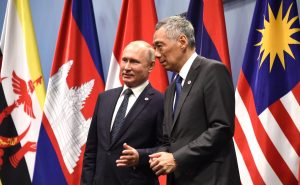After a long absence of nearly 30 years, Russia is more involved in Southeast Asia than it has been since the Cold War ended. While the punditry is obsessed with China’s influence in the region, it’s worth reviewing recent Russian activities. Russia will always be a minor player in the region, dwarfed by China and the United States, but Southeast Asia is a cost effective place for Moscow to advance some of Russia’s national interests. Although its influence in Southeast Asia is largely predicated on arms sales, Moscow has proven to be adroitly opportunistic, especially when it perceives weakness or disengagement from Washington.
Southeast Asia is peripheral to Russia’s security interests, which entail a buffer around Russia and frozen conflicts that it can escalate or de-escalate at will, using asymmetric force, “little green men,” active measures, and cyber operations. While Russia’s security posture has an implicit recognition of “spheres of influence,” it clearly sees an opening in Southeast Asia.
Southeast Asia is far from Russia’s borders and while its security interests may be peripheral, the region does have utility for President Vladimir Putin. Southeast Asia has proven to be a very low cost place, free of prolonged conflicts that could drag Russia into another Syria-like quagmire, to advance five key Russian interests:
- Undermining the U.S.-led liberal international order;
- Sowing mistrust in democracy and promoting authoritarian-led governance;
- Undermining the United States’ network of alliances;
- Ensuring that Russia has a seat at the table to resolve any global issue, and indeed reminding states that Russia still has global interests and is not just a European power; and
- Not just selling arms, but rendering the Countering America’s Adversaries Through Sanctions Act (CAATSA) sanctions effectively moot.
The End of the Cold War
In 1991, following the collapse of the Soviet Union, Russia relinquished its naval base in Vietnam’s Cam Ranh Bay. While some face was saved with the concurrent U.S. withdrawal from Subic Bay in the Philippines, it was still a humiliating retreat for a bankrupt Russia. Moscow, however, continued to maintain a signals intelligence facility in the country.
By 1990, all Soviet military and economic assistance to Vietnam and its two clients, Cambodia and Laos, ceased. While sizable at the time, the aid was largely wasted due to the economic inefficiencies of central planning. Throughout the 1980s, Russia provided Vietnam with an average of $1 billion annually in military assistance and another $1 billion annually in economic assistance; it also provided roughly $1 billion a year to the governments of Laos and Cambodia, then clearly satellites of Hanoi. Nonetheless, Russia had little to show for its investments in the region. Indochina was a blackhole that Moscow shoveled rubles into, and its influence immediately dissipated.
Russia’s first foray back into Southeast Asia came through arms sales to a new customer base, in a desperate attempt to keep Russian weapons factories open. Russia began to supply Malaysia and Indonesia with fighter jets, weaning them of their reliance on Western armaments.





























